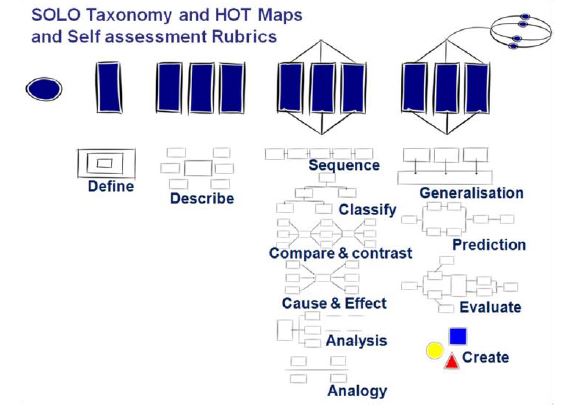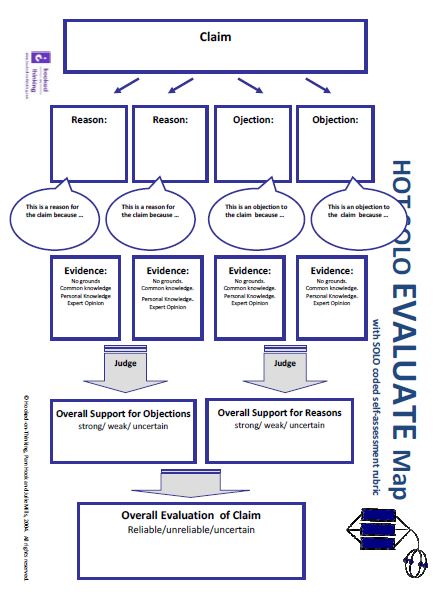Over the past fourteen years, as a headteacher, I have led many professional development sessions for staff and introduced a number of different strategies and initiatives. Without doubt the one that is most often been reflected back to me as having the greatest impact was introducing staff to the SOLO Taxonomy. It has helped teachers structure the learning within lessons, projects and schemes of work in a sequential and increasingly complex manner. The structuring and sequencing of learning is at the heart of what great teachers do in their lessons, projects and courses so maybe it should be no surprise of the extent of its impact.

Overview of SOLO Taxonomy and HOT Maps.
Reproduced with the kind permission of Pam Hook http://pamhook.com/
The benefits have moved beyond individual teachers to our work as a school since SOLO has become our shared language and in part the language is shared by the students. If you want to know more about the SOLO Taxonomy (Structure of the Observed Learning Outcomes) my introductory post, Using SOLO to Increase Challenge may help.
Pam Hook (@arti_choke) has spent years developing resources, presenting and leading workshops on the use of SOLO Taxonomy. Her website, HookED, is a treasure trove of ideas and resources. The following resources are being shared with the kind permission of Pam under the Creative Common Licence.
Compare & Contrast

HOT SOLO Compare and Contrast.
Reproduced with the kind permission of Pam Hook http://www.pamhook.com/
HOT Compare and Contrast Template_2010 V1
Students up and down the country (and internationally) will compare and contrast numerous things. This can be characters in a play, geographical features like river valleys, views of different religions or secularists on marriage, death or the after life and differences between mixtures and compounds in Science. The problem is that this can remain at a low level descriptive outcome if we are not careful.

HOT SOLO Compare and Contrast Visual Rubric – Prestructural To Multi-structural
Reproduced with kind permission of Pam Hook http://www.pamhook.com/
Students can describe what a mixture and a compound is but don’t explore why they are different. The real potential of SOLO is in scaffolding the learning towards more sophisticated thinking at a relational or extended abstract level. When preparing lessons it is crucial that teachers are absolutely clear where the learning is going, from shallow to deep, from the necessary factual knowledge towards the more conceptual understanding.

HOT Visual Rubric Compare and Contrast – Relational and Extended Abstract.
Reproduced with the kind permission of Pam Hook http://www.pamhook.com/
As students are required to explain the descriptions that they have made, for example about mixtures and compounds, they begin to look at the core of the subject or discipline – Chemistry is all about the relationship between particles and the factors that affect them. The relationship (bonds) between the particles in mixtures and compounds are fundamentally different and students need to understand this.
Evaluation
Increasingly students are being required to evaluate both within the classroom but also the examination hall. The “evaluate” element of a question, due to the complexity of thinking required, is often very heavily weighted in terms of the number of marks available. We need to be able to drill our students into a way of thinking and a way of structuring their responses.

HOT SOLO Evaluate Map
Reproduced with the kind permission of of Pam Hook http://www.pamhook.com/
The rubric below helps both teachers, in the first instance, and students to take a structured approach to evaluating a particular claim. Moving from evaluating a claim with “for and againsts“, to explaining why these are relevant and eventually looking at the weight of the arguments to come to a reasoned judgement. This is a useful skill in life as well as the examination hall.

HOT Visual Rubric Evaluate – Multistuctural to Extended Abstract
Reproduced with the kind permission of Pam Hook http://www.pamhook.com/
The power of the SOLO Taxonomy – and the resources produced by Pam Hook – is that it is content free. You can use it in any subject and for any content including procedural and meta-cognitive knowledge as well as factual to conceptual knowledge. Thanks to Pam for her genius and generosity in sharing these resources.
This is just a mini-blog (a bloglet if you like) about the benefits of incorporating the SOLO Taxonomy into your everyday practice. It is not a gimmick or a quick fix but at the heart of Teacher Clarity and the raising of achievement.
I’ll composed another bloglet soon – #SOLO Seventh Heaven with some more of the great resources you can find on Pam’s website.

SOLO Books available from http://pamhook.com/store/



Hi Stephen,
Thanks for this thoughtful sharing.
I love the quote – you have captured the essence of the classroom based approach to using SOLO Taxonomy.
“It is not a gimmick or a quick fix but at the heart of Teacher Clarity and the raising of achievement.”
With your permission I will drizzle it across my work with teachers this year.
Regards
Pam
Posted by Pam | February 22, 2014, 7:23 pmThanks Pam. Feel free to use the quote as we’re in your debt given everything you have shared over the years.
Posted by ExecutiveHT | February 22, 2014, 7:30 pmThanks for this post. Been meaning to get started on implementing SOLO somehow but always putting off the mountainous task. This has been a wonderful start with great resources. Thanks for sharing. Top man.
Posted by marvinsuggs | February 23, 2014, 7:44 amYou’re welcome. Credit really needs to go to Pam Hook for all her work. Sharing a few more of Pam’s resources in a couple of weeks #SOLO Seventh Heaven.
Posted by ExecutiveHT | February 23, 2014, 2:18 pmReblogged this on Learning Curve and commented:
This is a great resource for critical thinking skills…and more.
Posted by RBlake | December 26, 2014, 8:56 pm